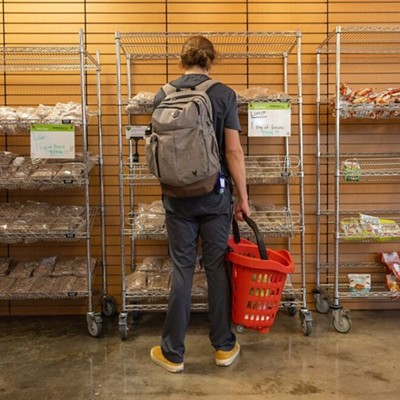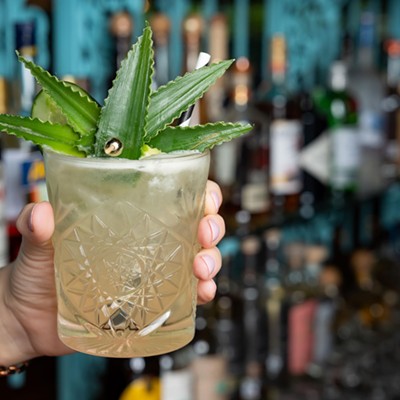Although it's not officially fall yet, plump orange pumpkins are resting on mounds of hay and dirt in and around two plots that -- along with dozens of others -- make up the 1,100 square feet White House Kitchen Garden. It's a warm day in early September and the garden is sprawled out like a sunbather across the South Lawn of the White House. You can see the mansion over a grassy hill, although the gardens are closer to E Street than they are the White House itself.
Bees from the White House's own apiary only a few feet away are dipping in and out of squash blossoms near the ground, buzzing the heads of visitors as they make their way back to the hive. The entire area is thick with the heady, horse-stall smell of mulch. On one giant thresh of tomato vines, Sungold tomatoes are hanging in grape-like clusters.
"Eat some!" encourages Bill Yosses, the pastry chef at the White House. Along with executive chef Cristeta Comerford, Yosses is leading a small group of food journalists on a tour of the White House Kitchen Garden. Everyone excitedly picks a tomato or two from the vine and pops them into their mouths, the tiny, sun-warmed tomatoes sweet like candy.
Planted under the instruction of First Lady Michelle Obama in March 2009, the White House Kitchen Garden stands as both a symbol of the current administration's attitude toward food and the role that it plays in our overall health, as well as a reminder that at-home gardens weren't such a novelty a few generations ago.
First Lady Abigail Adams planted the first White House garden over 200 years ago, and First Lady Eleanor Roosevelt planted the Victory Garden to inspire all victory gardens on the White House lawn in 1943. Before long, victory gardens were responsible for producing 42 percent of America's fresh produce.
And while there hasn't been quite the same national response to the Obamas' garden, it's still clear that Comerford and Yosses are invested in it nevertheless -- and invested in the example that they hope it sets for others.
"This garden isn't just for show," Comerford emphasizes, clad simply in cuffed jeans and Chucks as she mucks her way through the damp soil with the group. Yosses looks slightly more formal in a chef's jacket and black pants, and he's careful to point out where spindly vines or stray roots are poking out from their beds so as not to trip anyone.
"We have to be more seasonal," says Comerford, continuing right along. "We have to be more aware of what's growing -- let nature dictate what's on the menu rather than the chef."
The White House Kitchen Garden is so named because Comerford practices what she preaches: Almost all of the produce grown on site is used in her own kitchen to feed everyone from visiting dignitaries to the First Family, and her menus are determined in large part by what they can glean from the garden that week. The rest of the produce doesn't go to waste, however.
"You can only use so many peppers," Comerford laughs, before admitting that excess yields -- of which there are often many -- get donated to food kitchens and charities in the Washington, D.C. area.
Another admission: The garden isn't organic. At least, not fully. The White House staff uses organic gardening practices, says Yosses, but the ground that the 60-odd fruits and vegetables are growing in didn't lie fallow for the required length of time prior to planting. That shouldn't matter, though, Yosses says.
"As much as I admire organic," Yosses explains, "the point of this garden is not 'organic.' If we want kids to eat vegetables, just buy vegetables from a good farmer -- from a place where they're grown as best they can."
Finishes the pastry chef: "We just want kids to eat healthy."
A few minutes later, he cautions a good-natured reporter who gets too close to the apiary: "Be careful. That's the bees' flyway."
In addition to the huge yield from the Kitchen Garden, the bees produced 175 pounds of honey last year alone -- and from only one hive. Not bad, considering the bees were an afterthought of sorts, encouraged along by a White House carpenter who kept bees as a hobby. These days, the honey is used for everything from topping toast to brewing beer.
"We make honey porter, honey brown and honey ale," says Comerford of the beer that's brewed on-site at the White House, the result of President Barack Obama's keen interest in homebrewing. (He's in good company; Thomas Jefferson was an avid homebrewer too.) The focus of intense curiosity in the past few weeks, recipes for the beer -- which is the first to be brewed at the White House -- were recently published on the White House's official Web site. And they're still the talk of the tour today.
"It's the topic of the moment," Yosses jokes, as the half-hour tour begins to wrap up. Comerford has left to pick her kid up for gymnastics and Yosses is leading everyone back towards the White House.
Emboldened by the cheerful and plentiful responses to their questions, one of the journalists points to a wooden birdhouse on a post and asks Yosses a final question: "Are there any birds nesting in that birdhouse?"
"No," laughs Yosses. "That's a security camera."
Follow Eating Our Words on Facebook and on Twitter @EatingOurWords





